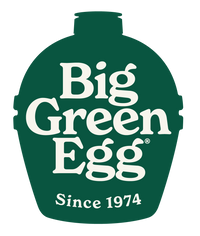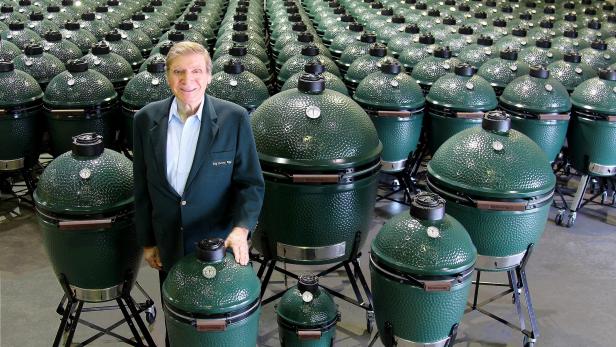The Big Green Egg as we know it today goes a long way back and is basically the result of a literally age-long development process. Let us take you through the history of the Big Green Egg!
The path to the business of barbecue fame has been a long and circuitous one for both the Big Green Egg and its chairman and founder, Ed Fisher. To trace this path, you’d have to rewind thousands of years. It was then that the original concept for an enclosed clay cooker first took root in Asia. Centuries later, U.S. service members came across the “kamado” in Japan immediately following World War II, and after experiencing how much better foods tasted, many soldiers shipped them home.
Ed Fisher grew up in Philadelphia and graduated from Temple University before enlisting in the Navy. Upon returning home, he set his sights on opening a small business, and in 1974, The Pachinko House opened its doors in Atlanta, Georgia. He decided to import two Japanese products he thought would sell well in America: the popular Japanese arcade game of the same name and these clay kamado grills.
Ed had also experienced the incredible taste of food cooked on the kamado and knew immediately this was a unique product. He placed one of the first imported kamados outside his store on the sidewalk and cooked chicken wings to draw in customers. “I had a big overhead at the time: a 400-square-foot store and 20 or 30 of these kamados in the back,” said Ed.
“I wasn’t sure that anybody would go for this thing because, at that time, the metal grills were what everybody had. It only took thirty minutes to make my first sale.” I figured, “Well, maybe I got something here.” - Ed Fisher, Founder
He knew he had to get the word out, and the only way he could afford to do this was through weekly advertising in the local newspaper, The Atlanta Journal-Constitution. Ed was dedicated to advertising the kamado cooker, along with other eclectic products he sold including pachinko games, electric bug killers, heaters, trampolines, and even backgammon boards. Ed learned quickly that the kamado cooker was the big winner. Over time, the kamado began to take center stage with customers. He began to host weekend demonstrations and special promotions and began to sell units one by one. It was a slow process – but a labor of love for Fisher – who knew he could win over more and more customers with the delicious food he was cooking. Little by little, sales of the unusual cooker grew.

In the early 1980s, he realized the need to simplify the sizes and colors being offered. It was this epiphany that drove Ed to figure out a way to manufacture this elliptical-shaped cooker into a product that he could mass produce and control the quality of the ceramics and accessories.
At the advice of a friend, he ventured down to the Georgia Institute of Technology to talk to some of the engineers about ceramics. It was here that it was suggested he look into ceramic manufacturing capabilities in Mexico, where many state-of-the-art factories were located. Ed set off, hoping just to find a source of replacement parts, and the journey led him to the largest ceramic manufacturer in the world. “I’ve been very lucky throughout my career, and it was a stroke of luck that I came upon this factory in Mexico,” says Ed. “They’re a very sophisticated company with a lot of brilliant people at the plant — PhDs walking around in white coats and devising different types of formulas for the clays.
“I needed to make consumers aware that this was no ordinary kamado, and the concept of a free lifetime warranty would really set us apart. We also found out that it was to our advantage if we replaced a broken part for somebody and honored that lifetime warranty. So rather than being a cost to us, I think it was an important marketing step. We still do it today!”
“In the beginning, we called it a kamado, which is a Japanese word that means oven or furnace,” says Ed. “But it didn’t make sense to try to sell a kamado in a pachinko store. It bothered me for a couple of years. And one day, I figured we’ve got to do something about this. So, in the store was a salesman from the newspaper, he was there to pick up an ad. In those days, we used to dictate the ad while the salesman was there. He asked, “Well, are you ready?” “No, I said, we’re going to make some changes. We can’t go on like this.”
Ed looked at what he had in the inventory and said, “Well, it’s big. Let’s start with that.” “It pretty much looks like an egg. And there were various colors. I could have used any color at that time. Brown, green, red. I mean, it would’ve served the same purpose. But there was something about green that registered in my mind. Maybe because I wanted something outrageous. You know, there weren’t too many products being marketed in green. It was outrageous enough. It’s going to catch somebody’s attention if they see this ad. Let’s call it the Big Green Egg and see what happens. The rest is history!”

Fifty years and many EGGs later, the product is still sold by the philosophy of tasting is believing. Product demos and personal referrals from satisfied owners are still at the core of Big Green Egg’s success. An expanding worldwide community of Big Green Egg devotees known as “EGGheads” share an unbridled passion and enthusiasm for the product, which is responsible for building the Big Green Egg and converting many people to live fire cooking on the EGG. “It is rather amazing that we’ve been able to take a cooking concept virtually unknown in the U.S. and catapult it to the most talked-about grilling, roasting, baking, and smoking product in the world,” says Ed.
The EGG has become the darling of many world-renowned chefs, celebrities, social media influencers, and cookbook authors who espouse cooking over all-natural lump charcoal for its flavor benefits. More and more competition barbecue chefs, who virtually always cook over charcoal, also prefer the EGG, which is helping them win many coveted championships.
Over the years, the Big Green Egg Company has transitioned from a small niche manufacturer to a prominent outdoor living space and grill industry player. Headquartered in Atlanta, Georgia, in a modern building with everything from research and development to photography and video studios (staying true to its roots, company headquarters also has a spacious retail store) and a Culinary Center that offers a variety of consumer classes, demos, private functions, and corporate events. Staying true to the ‘green’ in its name, visitors can even charge EV vehicles on site.
Today, the EGG is available in over fifty countries around the world, in seven sizes ranging from portable to ‘cook for the neighborhood’. Hundreds of accessory products have been introduced, from ceramic baking stones to multi-tiered cooking grid systems that significantly increase the cooking space, to its brand name line of natural lump charcoal in various woods. All these accessories are geared to expanding cooking capabilities and enhancing the experience.

Is Fisher pleased with the evolution of his ancient cooker? You bet. “But,” he adds, “evolution is an ongoing process, and we are constantly innovating, improving, upgrading, and introducing new items. Feedback from our enthusiastic EGG owners helps us focus on changes that ensure they will enjoy their EGGs even more. The EGG still has a long, exciting future ahead of it.”





